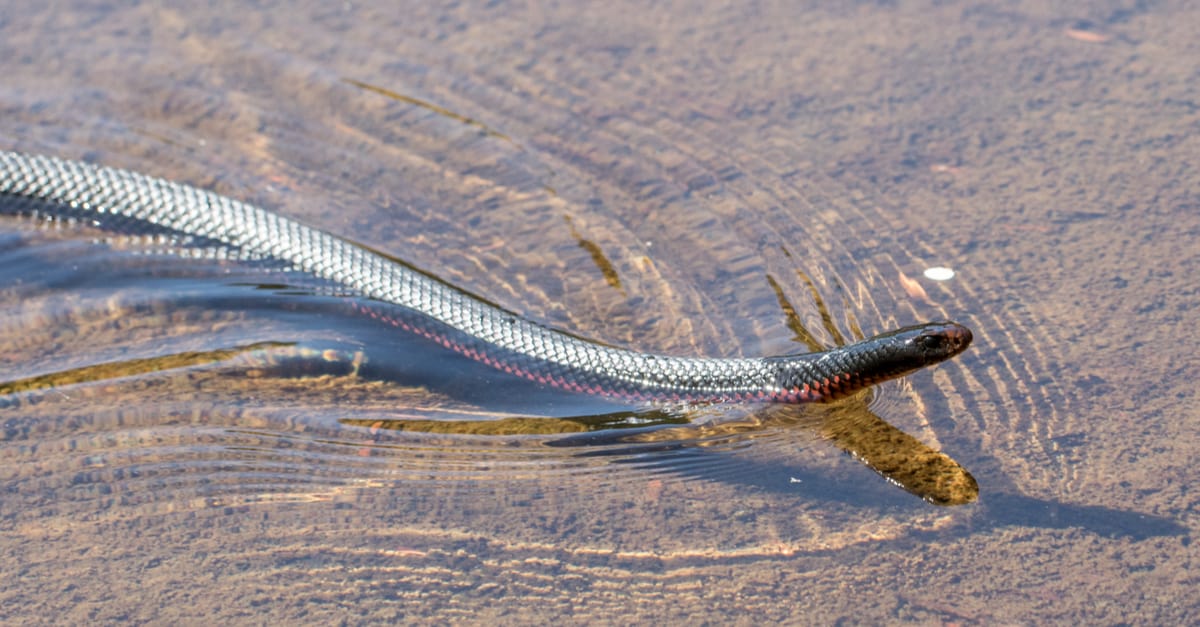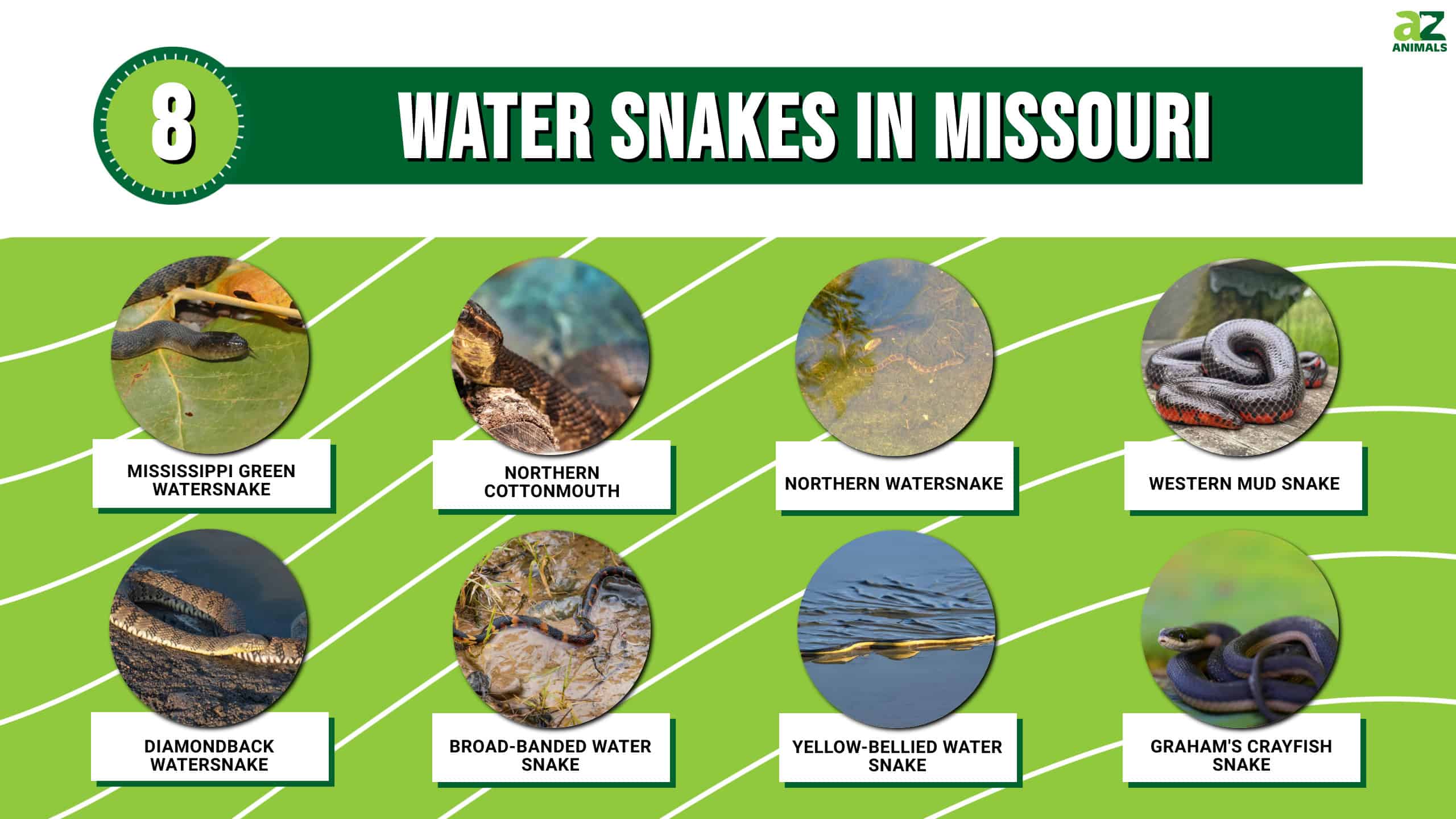
With its vast network of rivers and lakes, Missouri’s wetland habitats provide a diverse and captivating ecosystem. Among the fascinating wildlife found in these habitats, snakes hold a special allure. Missouri boasts an impressive collection of about 50 snake species, including eight water snakes. Let’s explore the realm of water snakes in Missouri and determine if any pose a danger!
8 Water Snake Species Inhabiting Missouri’s Waters
Missouri is home to these eight water snake species:
- Mississippi Green Watersnake
- Northern Cottonmouth
- Northern Watersnake
- Western Mud Snake
- Diamondback Water Snake
- Broad-banded Water Snake
- Yellow-bellied Water Snake
- Graham’s Crayfish Snake
Mississippi Green Watersnake
The Mississippi green watersnake, a decently-sized snake with a dark color and strong body, used to be abundant in southeastern Missouri. However, it’s no longer found in most parts of the region. Its back is greenish brown with a few small, hard-to-see dark brown or olive-brown patterns. The belly is dark gray with yellow markings shaped like half-moons. Though non-venomous, watersnakes bite for self-defense and release a strong-smelling musk from glands near the base of their tail.
Missouri’s Bootheel is home to several types of Mississippi green watersnakes. However, these harmless watersnakes often get mistaken for the venomous northern cottonmouth. Due to this confusion, the watersnakes are often harmed even though it’s unnecessary. To differentiate, cottonmouths have a bigger, more robust body, chunky head, darker coloring, facial pit between nostril and eye on each side, and a light line from eye to mouth corner.
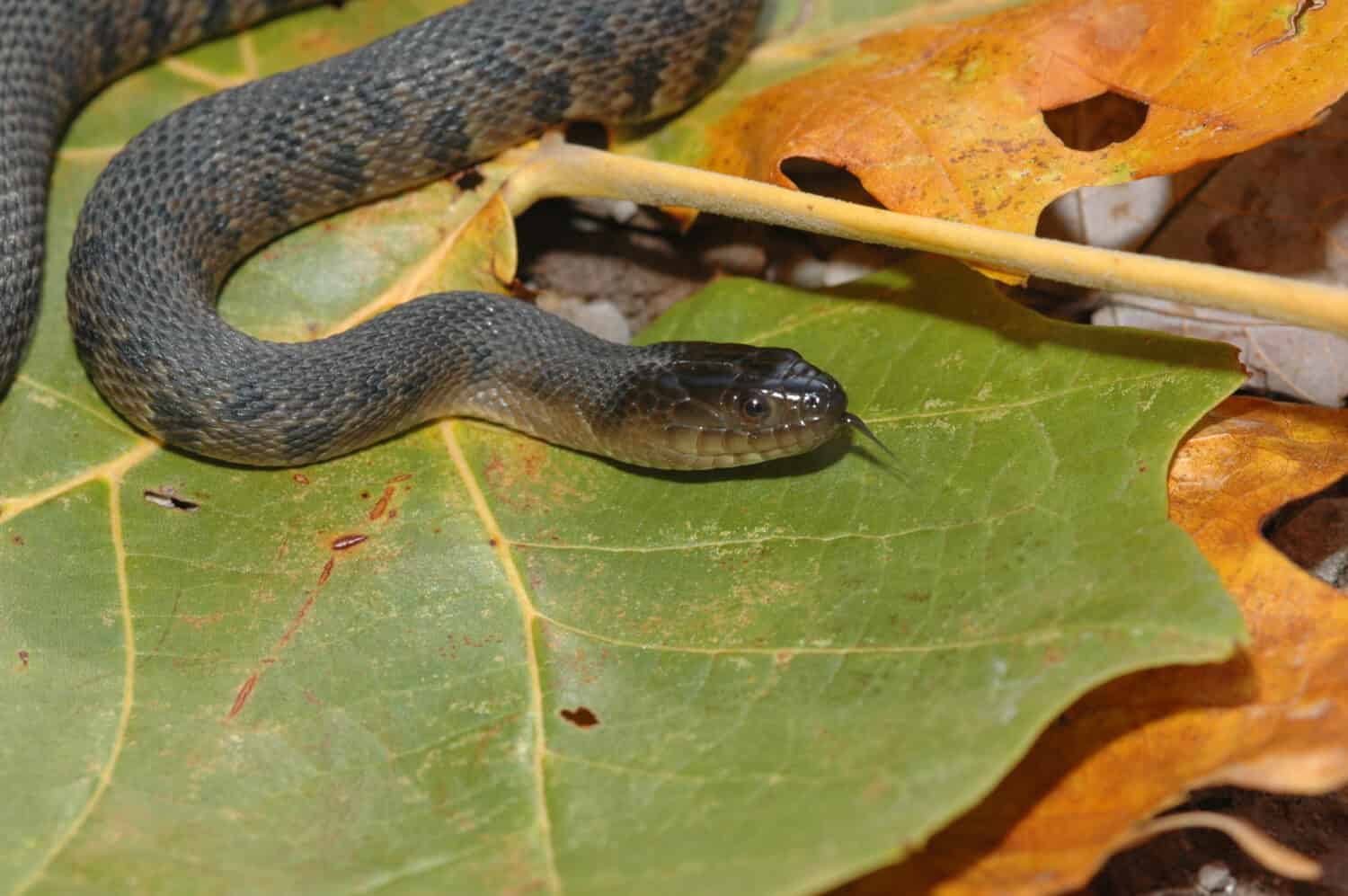
Though non-venomous, green watersnakes bite for self-defense and release a strong-smelling musk from glands near the base of their tail.
©Rusty Dodson/Shutterstock.com
Habitat and Conservation Status
This serpent usually lives in swamps, mainly cypress swamps and river sloughs in the Mississippi Lowlands of Missouri. It used to be abundant in southeastern Missouri but has become very rare. The significant decrease in natural cypress swamps has endangered this species in Missouri, and hasn’t been seen here in a while.
Missouri likely doesn’t have the Mississippi green watersnake anymore. However, some were seen in southern Dunklin County in 1994. Some dead specimens were found in Mississippi County, Arkansas, which is just across the border. Despite this, there’s a possibility that some Mississippi green watersnakes still exist in Missouri, which would be a valuable addition to the state’s wildlife.
Northern Cottonmouth
The northern cottonmouth is a snake that lives in water and on land. It is heavy and can be different shades of dark colors. The adult snake has unclear dark bands on its body. Its head is wider than its neck and is black or dark brown. Some have a black stripe from their nose to their neck, and most have a white upper lip.
Northern cottonmouths found in the Missouri Ozarks can have a range of colors, including dark shades. There can be differences in coloration between individuals in a population. These snakes have a big sensory pit between their nostril and eye on both sides of their head, letting them detect heat. Their eyes have vertical pupils, although they might not be visible due to their dark coloration.
The underside of these snakes is cream-colored and has black or dark brown patches and smears. The scales on their sides and back have noticeable ridges and a single anal plate. Juvenile northern cottonmouths have lighter colors, and their 10-15 broad crossbands are well-defined. Newborn cottonmouths have a greenish-yellow tip on their tails, which helps to distinguish them.
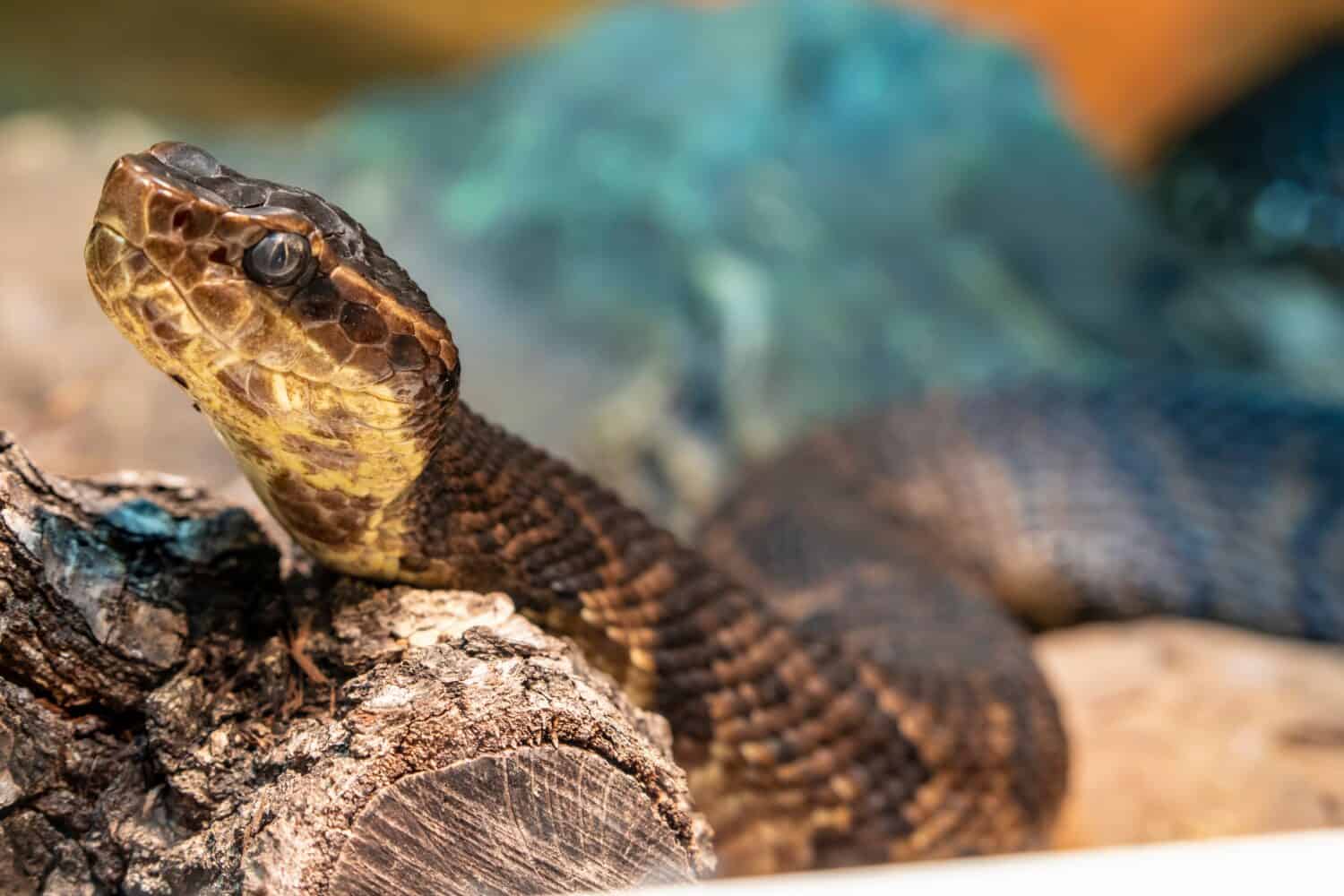
Northern cottonmouths found in the Missouri Ozarks can have a range of colors, including dark shades.
©Danny Ye/Shutterstock.com
Habitat and Conservation Status
The northern cottonmouth inhabits two distinct environments in Missouri. In southeastern Missouri, it resides in cypress swamps, oxbow lakes, sloughs, and drainage ditches near the Mississippi River. In the Ozarks, it can be found in scattered groups in cool creeks and small rivers fed by springs. Cottonmouths are active at night and usually prefer solitude. Cottonmouths are not facing endangerment or threat, and their population is steady across their habitat.
During winter, they tend to reside in rock crevices near limestone bluffs. Some cottonmouths move from lowland wetlands to forested upland areas in autumn and back to wetlands in spring. Other snake species, like timber rattlesnakes, western rat snakes, racers, and copperheads, sometimes share these denning sites. Cottonmouths in southeastern Missouri’s lowlands, with no rocky outcrops, may use various spots for overwintering, including old trees, animal burrows, hollow logs, and root channels.
Danger And Prevalence Of Cottonmouth Bites
When a cottonmouth snake senses a potential threat in a bush, it typically runs away but stays coiled and ready to defend itself in an open space. Cottonmouth snakes are called so due to their frequent display of wide-open mouths lined with white. The bite of the northern cottonmouth is highly dangerous and necessitates urgent medical attention to prevent a fatality. Within their known habitat, Cottonmouths contribute to around 7.3 per cent of venomous snakebites in the United States. In Missouri, cottonmouth bites comprise only 4-5 per cent of venomous snakebites.
Northern Watersnake
The northern watersnake can be gray or reddish-brown with many cross bands on its front that can be blackish, reddish-brown, or dark brown. Sometimes, people confuse it with a cottonmouth snake. Towards the back of the body, the bands become blotches. The snake’s belly is yellow or cream with black and reddish half-moon spots. As with other watersnakes, its back scales are rough-textured due to keels. When the snake is threatened, it defends itself by biting aggressively but is not venomous. It can also release a pungent musk from glands at the base of its tail.
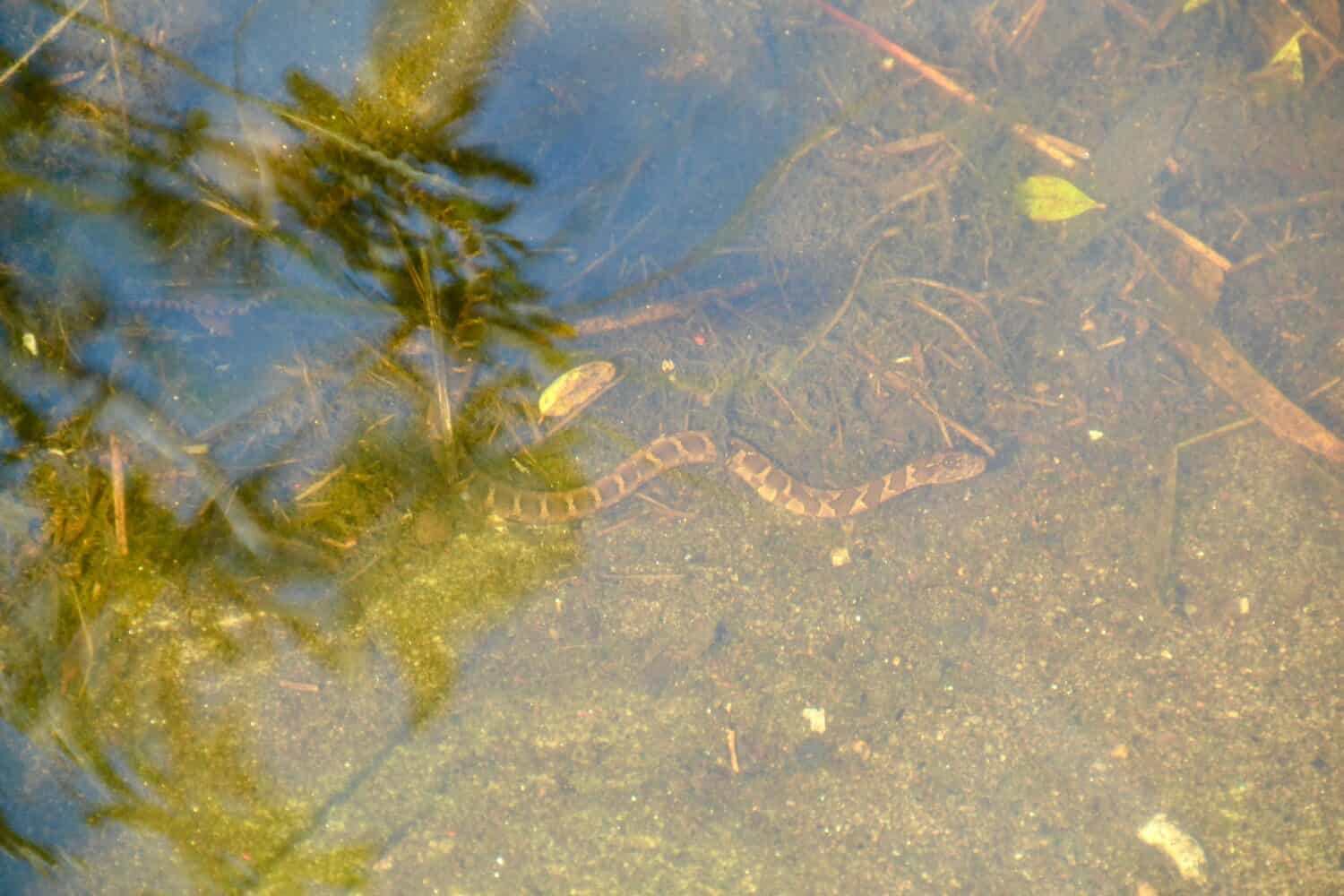
Although northern watersnakes can move overland, they stay close to their freshwater habitats.
©Chris Dale/Shutterstock.com
Habitat and Conservation Status
Northern watersnakes inhabit freshwater environments like lakes, wetlands, ditches, ponds, and slow-moving streams and rivers. They often bask in the sun on shallow water structures like piers, logs, branches, and docks. When not basking, they hide under cover, such as logs, rocks, and boards near the water’s edge. Although they can move overland, they stay close to their freshwater habitats. The northern watersnake population is not at risk and is classified as Least Concern.
Western Mud Snake
The mud snake is a massive aquatic snake that can grow up to 81 inches (207 cm) long and is not venomous. It’s so elusive and mysterious that people hardly ever see it. The adult mud snake’s back has a shiny black appearance, and its belly has a checkerboard design of red or pink and black. Sometimes, the red color even stretches along the sides of their body. They’ve got tiny, dark eyes and occasionally display a yellow hue on their head.
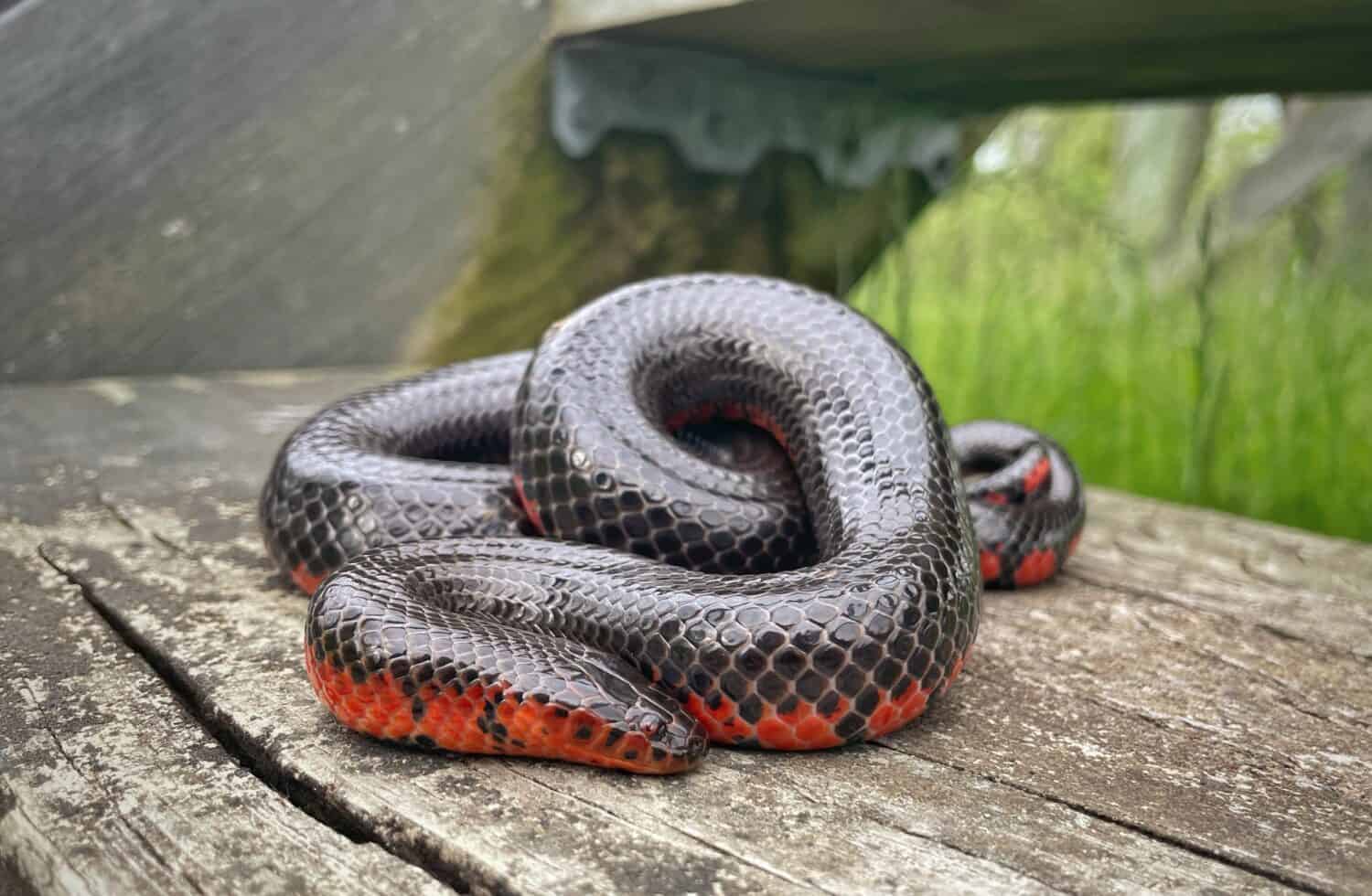
Despite their strong affinity for water, mud snakes can traverse considerable distances on land and are occasionally found far away from aquatic environments.
©200346204/Shutterstock.com
Habitat and Conservation Status
These snakes occupy diverse aquatic habitats such as seasonal wetlands, bays, ditches, cypress swamps, slow-moving streams, marshes, and the vegetated edges of ponds and lakes. Sometimes, young mud snakes live in seasonal wetlands and transition to more permanent water bodies as adults. These snakes occupy diverse aquatic habitats such as seasonal wetlands, bays, ditches, cypress swamps, slow-moving streams, marshes, and the vegetated edges of ponds and lakes.
Despite their strong affinity for water, mud snakes can traverse considerable distances on land and are occasionally found far away from aquatic environments. Mud snakes, though not often seen, are quite abundant in Missouri. Destruction or deterioration of wetlands, which they rely on for survival, could potentially jeopardize their existence.
Diamondback Watersnake
Adult diamondbacked watersnakes measure 30-48 inches (76-122 cm), with the longest recorded length being 69 inches (175.3 cm). They have a sturdy body and are light grayish-brown in color.
A distinctive chain-like pattern extends along their entire body. This pattern comprises dark blotches that run down the middle of the back, connected to rows of dark spots on the sides by short diagonal lines. The belly is yellowish with dark half-moons. Their scales have prominent raised ridges, known as keels, and they possess 25-31 scale rows at midbody. Their pupils are round. Juvenile diamond-backed watersnakes exhibit similar coloration to adults.
These snakes feed on freshwater fish and frogs. They catch their prey by seizing it with their jaws, bringing it to land, and then swallowing it. They don’t constrict their prey. Usually, they are active at night, but during the spring and fall, they may increase their daytime activity.
Like other North American water snakes, diamondback water snakes display high levels of aggression and inflict forceful, repetitive bites when confronted. Despite their ferocity, these snakes lack venom, resulting in minor harm, such as scratches, and the potential for infection from their bites.
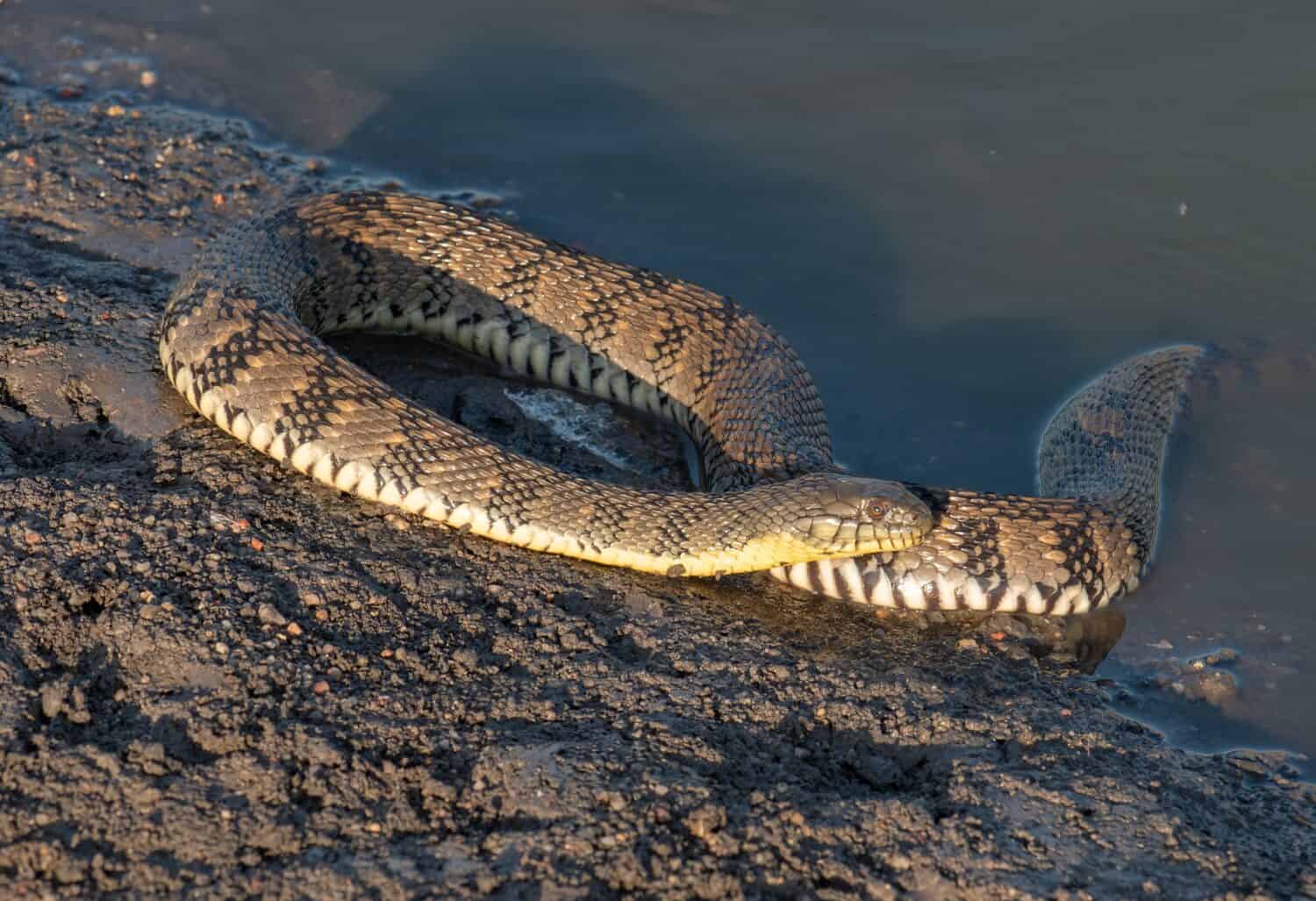
Diamondback water snakes catch their prey by seizing it with their jaws, bringing it to land, and then swallowing it.
©Gerald A. DeBoer/Shutterstock.com
Habitat and Conservation Status
Diamondback watersnakes can inhabit diverse freshwater environments but favor water bodies with vegetation hanging above. Diamondback water snakes aren’t in significant danger. However, in certain regions, they do confront habitat destruction and degradation alongside human unawareness.
People often confuse them with the venomous cottonmouth or rattlesnakes and kill them due to fear. In reality, diamondback and other water snake species are more prevalent than venomous snakes in their range, especially in areas with human activity.
Broad-banded Water Snake
The broad-banded watersnake is a nonvenomous snake that lives in water and on land. It has wide, irregularly shaped blotches or bands on its back, which can be black, brown, or red-brown, interspersed with yellow or yellowish-gray. Occasionally, there’s a faint dark line from the eye to the corner of the mouth.
The snake’s belly is yellow with black markings. Young ones have brighter colors than adults. When threatened and unable to escape, this species will flatten its head and neck, trying to defend itself vigorously. It can deliver fierce bites and release a pungent musk from glands at the base of its tail as a defense mechanism.
It eats small water creatures like fish, frogs, tadpoles, toads, and sometimes crayfish. Adults are usually 22 to 36 inches long. The largest recorded size is 45 inches. When threatened, it becomes aggressive and hostile, like other water snakes. It is active during the day. Broad-banded water snakes frequently appear in yards searching for water sources, particularly when the yard receives regular watering. Regularly watered yards attract toads and frogs — the snake’s preferred prey.
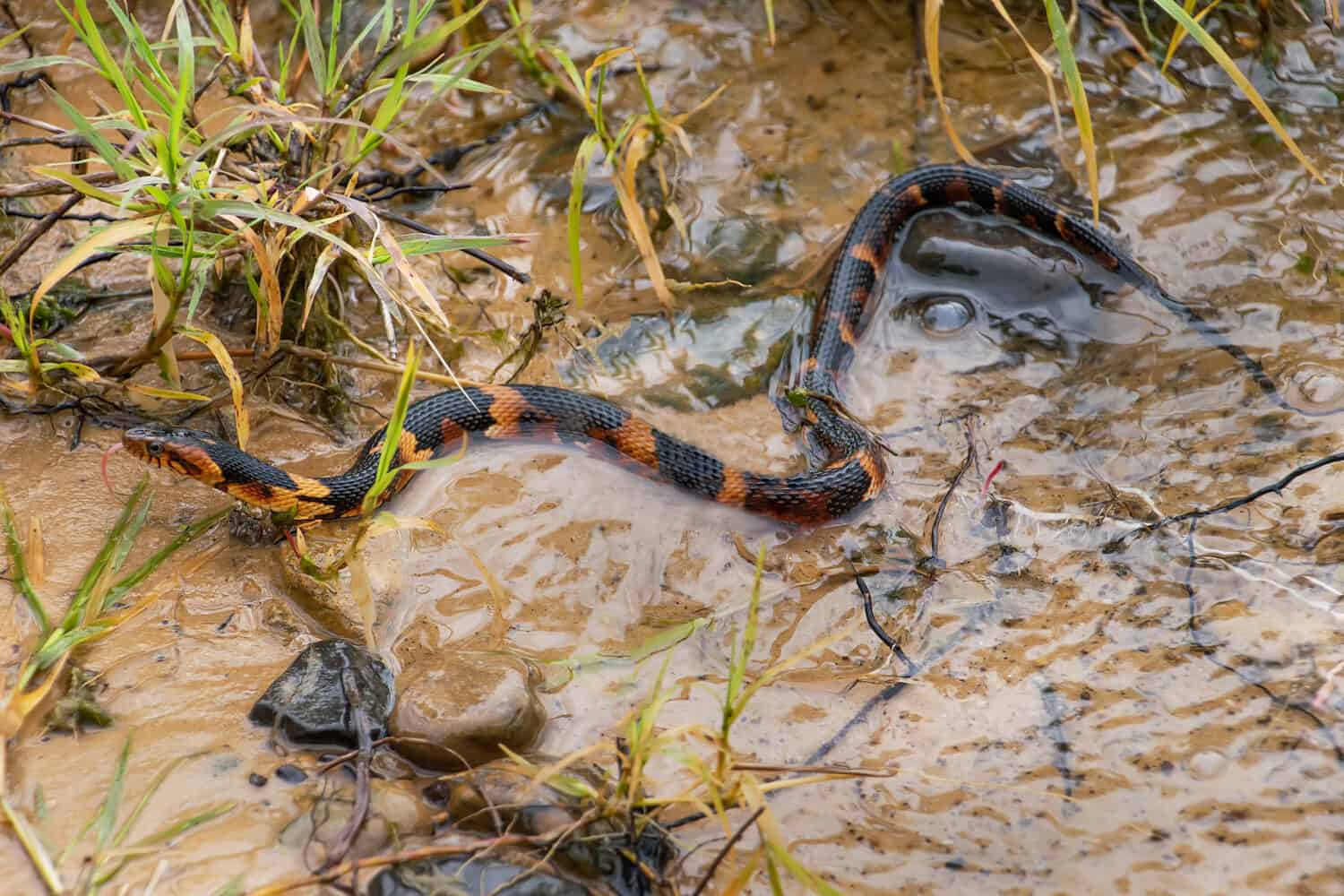
The broad-banded water snake has wide, irregularly shaped blotches or bands on its back, which can be black, brown, or red-brown, interspersed with yellow or yellowish-gray.
©William Cushman/Shutterstock.com
Habitat And Conservation Status
Broad-banded watersnakes, usually active at night, occasionally sunbathe on branches or logs above the water in cypress swamps, oxbow lakes, or river sloughs. Unfortunately, people often mistake them for western cottonmouths and unnecessarily harm them. The snake species is not in danger and has been classified as Least Concern by the International Union for Conservation of Nature (IUCN).
Yellow-Bellied Water Snake
Yellow-bellied water snakes can reach lengths of up to 4.5 feet. Their name comes from the distinct yellow underside they possess. Typically, their bodies display black or dark brown hues. These snakes have ridged scales aiding their movement in the water. Their bellies are yellow, while their dorsal scales exhibit dark patterns. The coloration often appears gray or dark brown, marked by dark patterns on the back.
Yellow-bellied sea snakes reproduce in warm oceanic regions, giving birth to live offspring after an approximately six-month gestation period. The females deliver their young in tidal pools. Once born, the mother departs, as these snakes are solitary creatures without social bonds.
Yellow-bellied water snakes usually display a non-aggressive nature towards humans and generally attempt to evade any potential conflict.
However, they might exhibit defensive behavior when they sense danger or are trapped. They can expand their bodies and emit a hissing sound to intimidate the perceived threat. If these deterrents prove ineffective, they may deliver a warning strike without opening their mouths. Consequently, it is crucial to demonstrate respect for their environment and refrain from needlessly disturbing them.

Yellow-bellied sea snakes reproduce in warm oceanic regions, giving birth to live offspring after an approximately six-month gestation period.
©John Fader/Shutterstock.com
Habitat and Conservation Status
Yellow-bellied water snakes reside near water sources such as:
- Marshes
- Swamps
- Rivers
Despite their lack of venom, they may be wrongly identified as venomous water snakes, generating misunderstanding and fear. Therefore, comprehending their physical characteristics and actions is crucial. The IUCN Red List indicates that the yellow-bellied water snake is considered a species of Least Concern.
Graham’s Crayfish Snake
The Graham’s crawfish snake is a snake that lives in ponds, marshes, streams, and prairies. It has a moderate size and a somewhat dull coloration.
The upper part of its body is either yellowish brown or brown, with stripes of a yellowish-tan hue running alongside. A barely detectable tan stripe might be running down the middle of its back. On the underside, the snake’s belly is light yellow or cream, with a faint line of golden brown or gray spots in the center and a wavy decoration of dark brown along both edges. When captured, these snakes refrain from biting and release an unpleasant odor that combines musk and fecal scents.

Unfortunately, the Grahams crayfish snake is often mistaken for a cottonmouth and unnecessarily harmed like other water-associated species.
©Rusty Dodson/Shutterstock.com
Habitat and Conservation Status
The Graham’s crayfish snake lives in marshes, ponds, sloughs, and crayfish burrows near calm prairie streams. It remains active from April to early November and tends to seek warmth among branches that hang over the water during spring and early summer.
When the weather gets hot, it switches to being active at night. During winter, it seeks refuge in crayfish burrows. Unfortunately, this snake is often mistaken for a cottonmouth and unnecessarily harmed like other water-associated species. According to the IUCN Red List, Graham’s Crayfish Snake is classified as a species of Least Concern.
Reflections On Missouri’s Eight Water Snakes
Missouri’s wetlands house a stunning array of creatures, including various snakes. In this state, there are eight species of water snakes, such as the Mississippi green watersnake, northern cottonmouth, and northern watersnake. The Mississippi green watersnake, unfortunately, is rarely seen and may even be extinct in Missouri due to the destruction of its habitat.
Cottonmouths are large snakes that come in various shades and possess a highly venomous bite; they’re responsible for approximately 7.3 percent of venomous snakebites in the United States. The harmless northern watersnake often gets mistaken for the cottonmouth due to its resembling appearance. Snakes hold an essential role in the ecosystem. While it’s crucial to be aware of potential risks they may present, it’s equally vital to show respect and safeguard their habitats.
Summary of the 8 Water Snakes in Missouri
Here are the 8 Water Snakes in Missouri:
| Rank | Water Snakes |
|---|---|
| 1 | Mississippi Green Watersnake |
| 2 | Northern Cottonmouth |
| 3 | Northern Watersnake |
| 4 | Western Mud Snake |
| 5 | Diamondback Watersnake |
| 6 | Broad-banded Water Snake |
| 7 | Yellow-Bellied Water Snake |
| 8 | Graham’s Crayfish Snake |
Discover the "Monster" Snake 5X Bigger than an Anaconda
Every day A-Z Animals sends out some of the most incredible facts in the world from our free newsletter. Want to discover the 10 most beautiful snakes in the world, a "snake island" where you're never more than 3 feet from danger, or a "monster" snake 5X larger than an anaconda? Then sign up right now and you'll start receiving our daily newsletter absolutely free.
Thank you for reading! Have some feedback for us? Contact the AZ Animals editorial team.

